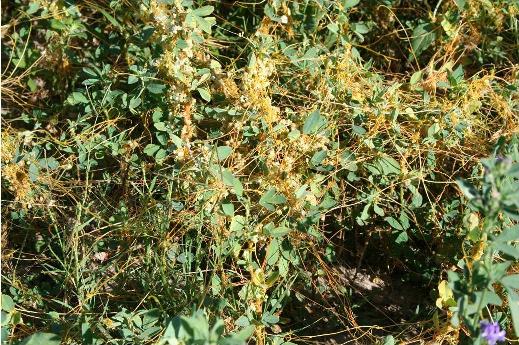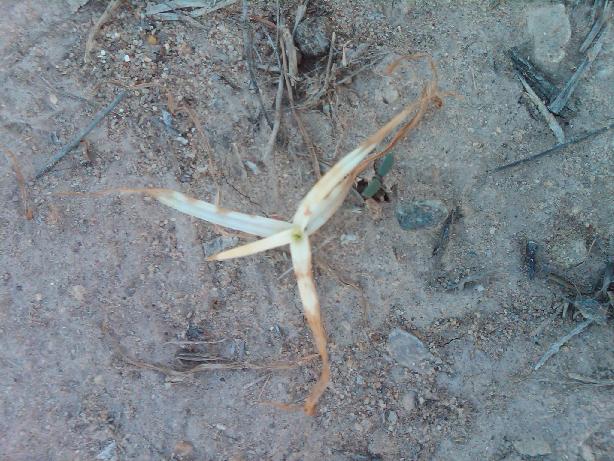 |
|
|
|

|
|||
| |
|||
Dodder has been a difficult to control weed in this area for a long time but it seems to be getting worse in recent years. It is listed as one of the 10 most problematic weeds in the U.S. by the Department of Agriculture. There are more than 150 species of dodder. Fifteen of these can be found in Arizona, 3 are common and one, field dodder (Cuscuta campestris), is a problem in the lower Colorado River region. It can be a problem on many crops grown during the summer months including melons, safflower, asparagus, sugar beets, beans, alfalfa and others. Dodder is one of the most unusual weeds we have to deal with. It is a parasitic annual that has no leaves or roots after it is attached to a host. It obtains all of its energy from the plants it attaches to. Dodder germinates near the soil surface and lives off of food reserves in the seed. It must attach to a host within 5 to 10 days or it will die. After it has found a suitable host, it produces adventitious roots called haustoria that grow into the vascular system of the host plant. After it is attached, the lower portion of the dodder seedling dies and all contact with the soil ends. Dodder seed is small, about 1/16 inch in diameter, and germinates in the spring or summer once the soil temperature reaches about 60 degrees. Each plant can produce several thousand seeds. The seed is hard and less than a third can germinate the following season. The remainder can remain dormant but viable for 20 years or more. The seed is small and light enough to float in water and blow in the wind. Most of the movement is probably from contaminated crops, seed and equipment. Controlling this weed starts by reducing seed movement into an area. Most states and countries have laws that prohibit the import of dodder seed. Only certified seed should be planted. A major cause for the spread of dodder in Arizona has been in non- certified alfalfa seed. Once it is present in a field, annual crops that are poor hosts can reduce the spread of this weed. Poor host crops include grasses, grains, and other monocots. Other weeds can serve as hosts and should be eliminated. Preemergent herbicides can be effective in keeping this weed from becoming established. Postemergence herbicides need to at least temporarily destroy the host. Perennial crops, like alfalfa, can be temporarily burned to the ground with contact herbicides like Gramoxone, Chateau or Scythe plus an adjuvant. Dodder can be selectively killed with glyphosate in Roundup Ready Alfalfa. The most effective control is with preemergent herbicides. These include trifluralin, pendimethalin, benefin, Dacthal and others. When the level of these herbicides has dropped to sub-lethal amounts, dodder seed will germinate and survive. Repeated applications are normally required.
Oops, sorry! Solicam (norflurazon) was accidentally left off the
To contact Barry Tickes go to: btickes@ag.arizona.edu. |
|||
| Back | |||
For questions or comments on any of the topics please contact Marco Pena at the Yuma Agricultural Center. |
|||
| Home | Cotton
| Veggies | Forages
| Grains | Citrus
| Crop x Crop Insects | Diseases| Weeds | Pesticides | Economics | News | Weather | Research | Photos | Contacts | General Info. Copyright © 2001 University of Arizona, College of Agriculture and Life Sciences Webmaster: Al Fournier (acis@ag.arizona.edu) |
|||

